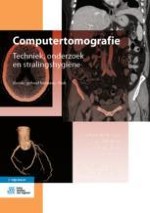Gepubliceerd in:
2021 | OriginalPaper | Hoofdstuk
31. Risicoanalyse
Samenvatting
Inhoud – 1 Inleiding – 2 Kansgebonden effecten – 3 Niet-kansgebonden effecten – 4 Zwangere vrouwen. – Van oudsher is men gefocust op het verminderen van kansgebonden effecten bij CT-onderzoeken. Tegenwoordig tracht men zowel kansgebonden als niet-kansgebonden effecten te verminderen op CT. In dit hoofdstuk wordt op grond van getallen een risicoanalyse gemaakt van de ernst van CT-onderzoeken. Daarnaast wordt aandacht besteed aan CT bij zwangere vrouwen.
